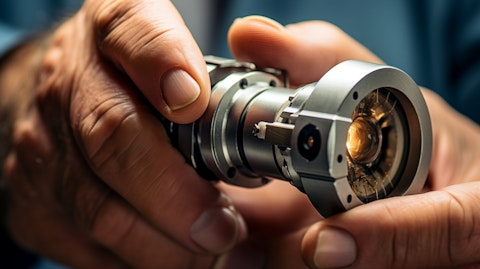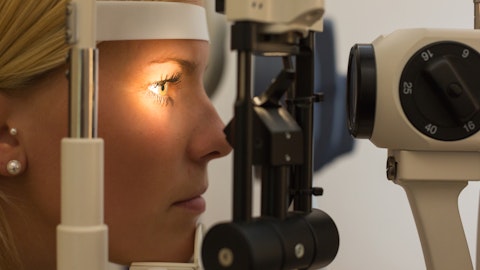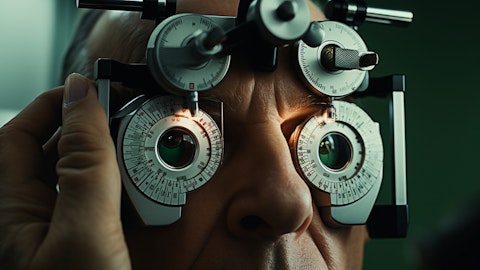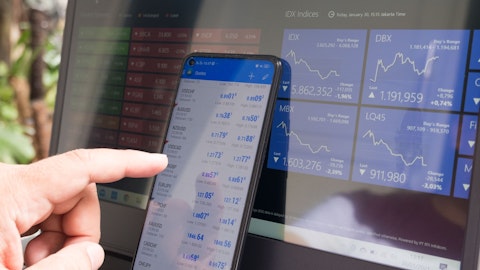RxSight, Inc. (NASDAQ:RXST) Q4 2023 Earnings Call Transcript February 28, 2024
RxSight, Inc. beats earnings expectations. Reported EPS is $-0.26, expectations were $-0.36. RXST isn’t one of the 30 most popular stocks among hedge funds at the end of the third quarter (see the details here).
Operator: Good day and thank you for standing by. Welcome to the RxSight Fourth Quarter 2023 Earnings Conference Call. At this time, all participants are in a listen-only mode. After the speakers’ presentation, there will be a question-and-answer session. [Operator Instructions] Please be advised that today’s conference is being recorded. I would now like to hand the conference over to your first speaker today, Oliver Moravcevic, please go ahead.
Oliver Moravcevic: Thank you, operator. Presenting today are RxSight President and Chief Executive Officer, Ron Kurtz; and Chief Financial Officer, Shelley Thunen. Earlier today, RxSight released financial results for the three-month and full-year ended December 31st, 2023. A copy of the press release is available on the company’s website. Before we begin, I would like to inform you that comments and responses to your questions during today’s call reflect management’s views as of today, February 28th, 2024, and will include forward-looking and opinion statements, including predictions, estimates, plans, expectations, and other information. Actual results may differ materially from those expressed or implied as a result of certain risks and uncertainties.
These risks and uncertainties are more fully described in our press release issued earlier today and in our filings with the Securities and Exchange Commission or SEC. Our SEC filings can be found on our website or on the SEC’s website. Investors are cautioned not to place undue reliance on forward-looking statements. We disclaim any obligation to update or revise these forward-looking statements. We will also discuss certain non-GAAP financial measures. Disclosures regarding these non-GAAP financial measures, including reconciliations to the most comparable GAAP measures, can be found in the press release. Please note that this conference call will be available for audio replay on our investor website. With that, I will turn the call over to our President and CEO, Dr. Ron Kurtz.
Ron?
Ron Kurtz: Good afternoon and thank you for joining us. In a moment, Shelley will be giving an update on RxSight’s financial performance for both Q4 and full year 2023. For context, I wanted to discuss key factors that we believe underlie the market success of Light Adjustable Lens and can drive RxSight’s performance over a sustained period. The eye care field is at the forefront of many of the change drivers in medicine, most notably reduced reimbursements to doctors and practices from third-party payers, who are facing rising costs from an aging population. For ophthalmic practices, the major opportunity to offset these cuts began in 2005, when ophthalmologists were first able to charge patients directly for the additional costs associated with so-called premium intraocular lenses or IOLs, that can reduce a person’s dependence on glasses after cataract surgery.
Growing from very low levels, premium cataract surgery now represents about 20% of the overall US cataract market and about 10% of the global market, with premium procedures projected to double over the next 10 years. By providing anywhere from $1,500 to $5,000 in additional revenue per eye, above and beyond the approximately $500 reimbursed by third-party payers, participation in the premium IOL market has become essential for ophthalmic practices to remain viable and continue to serve all their patients. Our sales efforts are concentrated on the roughly 4,000 US cataract surgeons who perform 70% to 80% of all premium IOL procedures, though the percentage of premium cases varies widely from doctor to doctor and practice to practice. One reason for this variability lies in the challenging clinical requirements for a broadly successful premium cataract procedure, namely, the ability to deliver consistent, high-quality vision across a range of distances.
With the commercial growth of the LAL and early introduction of LAL Plus, an increasing number of doctors recognize the power of adjustability to achieve this level of performance, in a way that has not been possible with fixed optic, nonadjustable intraocular lenses. With both the LAL and LAL Plus, doctors treat the actual refraction that is measured post-operatively, rather than trying to predict a result pre-operatively for the first time achieving LASIK-level refractive results after cataract surgery. The LAL platform of lenses delivers equivalent quality of vision to the gold standard monofocal IOLs, something that may not be possible with multifocal IOLs that reduce contrast vision and increase rates of visual symptoms, such as glare and halo.
In fact, over the past 20 years, doctors have moved away from higher levels of multifocality, limiting the improvement in near vision for patients. In contrast, using the LAL platform, doctors and patients can customize vision in both eyes to optimize the quality of vision over a range of distances. We believe that by tapping into these fundamental market forces, the LAL enables doctors to meet the vision goals of more of their patients as well as the financial goals of their practices, in turn driving RxSight’s superior performance in Q4 and full year 2023, as Shelley will now review.
Shelley Thunen: Thank you, Ron, and good afternoon, everyone. Consistent with our January preannouncement, RxSight reported fourth quarter 2023 revenue of $28.6 million, up 78% compared to a year-ago quarter. Growth was broad-based, reflecting both the continued expansion of our installed base of light delivery devices and a sharp increase in LAL procedure volumes. The favorable trends we observed throughout 2023 continue to be driven by surgeons’ growing recognition of the clinical and economic benefits provided by the RxSight system and the adjustability of our LAL technology. In the fourth quarter of 2023, we sold 77 LDDs, up 35% compared to the year-ago period. Fourth quarter 2023 LDD unit placements generated $10 million in revenue, representing a 52% year-over-year growth.

We ended 2023 within an LDD installed base of 666 units, up 67% compared to year-end 2022. LAL sales continue to rise in the fourth quarter of 2023, reflecting surgeons’ and patients’ growing preference for the superior clinical performance of our adjustable IOLs. We sold 18,071 LALs in the period, up 98% from the fourth quarter of 2022. These procedure volumes translated into LAL revenue of $17.8 million in the fourth quarter of 2023, also up 98% compared to the year-ago quarter. Higher LAL volumes during the fourth quarter also contributed to an increase in the LAL revenue mix, with LAL revenue representing 62% of total revenue, compared to 56% in the fourth quarter of 2022. This changed the mix coupled with the sale of our LDD with a lower cost to manufacture and a higher average selling price expanded our gross profit margin to 62% in the fourth quarter of 2023, compared to 46% for the fourth quarter of 2022.
Fourth quarter SG&A expenses were $21.2 million, up 35% versus the prior year period. This year-over-year increase in SG&A was primarily associated with increased expenses in sales and clinical personnel costs to support our growing installed base, as well as our first year of SOX implementation, consulting and audit cost. On a sequential basis, SG&A was up 11%, primarily due to an increase in sales, headcount and expenses related to the higher sales volume achieved in the fourth quarter. Research and development expenses for the fourth quarter of 2023 were $7.3 million, representing an increase of 10% year-over-year. The change versus a year ago quarter was primarily due to increased headcount and associated increase in salaries and stock-based compensation.
On a sequential basis, R&D expenses remained relatively stable with a 3% increase compared to the third quarter of 2023. We reported a net loss in the fourth quarter of $9.2 million or a loss of $0.26 per basic and diluted share using weighted average shares outstanding of 36 million shares. In the year-ago quarter, our net loss was $15.6 million or $0.56 per share on a basic and diluted basis, using a weighted average of 28 million shares. Note also that stock-based compensation in the fourth quarter was $4.4 million, resulting in an adjusted net loss of $4.8 million or $0.13 per basic and diluted shares. In the interest of time, I’ll provide a brief recap of full-year 2023 results. Revenue grew 82% to $89.1 million, driven by a 43% and 117% increase in LDD and LAL revenue, respectively.
Our 2023 gross margin was 60% versus 44% in 2022. Total operating expenses were $103.9 million in 2023, representing an increase of 23%, compared to operating expenses in 2022. For the full year of 2023, we reported a net loss of $48.6 million, or a $1.41 per share, versus a net loss of $66.8 million, or $2.41 per share on a basic and diluted basis in 2022. Excluding $15.7 million in stock-based compensation expense and $1.8 million in loss on the full extinguishment of our term loan in 2023, adjusted net loss was $31.1 million, or $0.90 per basic and diluted shares. Moving to the balance sheet. We ended the year with no debt and $127.2 million in cash, cash equivalents and short-term investments. During 2023, we raised $95.2 million net of fees and expenses from our at-the-market program and confidentially marketed public offering and paid off our $40 million term loan in full.
Adjusted cash use from operations was $33.9 million in 2023, down from $59.5 million in 2022. Finally, in our first year as a large, accelerated filer, we are proud to report that we had no material weaknesses or significant deficiencies in our SOX compliance, underscoring our commitment to financial integrity and operational excellence. Turning to the 2024 guidance. Consistent with the guidance we provided in January of this year, we continue to expect 2024 full-year revenue to be in range of $128 to $135 million implying year-over-year growth of 44% to 52%. We expect to see overall quarterly sequential growth with seasonality expected in the first and third quarters. Typically, the first quarter tends to be softer sequentially for capital equipment, in our case, the LDD with continued sequential growth in LAL procedures, but lower sequential growth than the seasonally strongest quarters, which are the second and fourth quarters.
We expect our gross margin to expand to a range of 65% to 67%, reflecting a continued increase in revenue mix from higher margin LAL procedure volumes as well as gross margin benefit from our LDD with a higher ASP and lower cost to manufacture. We continue to expect operating expenses to be between $125 million and $128 million, which represents an increase of 20% to 23% over the prior year and reflects ongoing investments we’re making to establish a large and durable postoperative light treatment infrastructure to support sustained LAL procedure growth. Included in our costs, primarily in operating expense, is non-cash, stock-based compensation expense of approximately $22 million to $25 million. Before I turn the call back to Ron, I am pleased to announce in conjunction with this year’s ASCRS meeting, we will be hosting an investor event on April 6th at 7:00 A.M. Eastern time.
Please stay tuned for more details from our Investor Relations team as the event date approaches. With that, I’ll turn the call back to Ron.
Ron Kurtz: Thank you, Shelley. While we are pleased with the strong finish to 2023, we’re also thrilled about the journey ahead. We’re particularly inspired by the opportunity to achieve our ambitious goals, which will leverage the immense talent and creativity of both the RxSight team and our clinical partners. Like any new clinical capability, adjustability requires both a financial and intellectual investment. But as I noted earlier, the benefits to patients and practices are clear. As we celebrate the 75th anniversary of the intraocular lens in 2024, it’s essential to recognize the eye care community’s investments in innovation. This commitment has ushered in advancements, from which we all benefit today, highlighting the importance of adopting change over maintaining the comfort of the status quo.
We look forward to highlighting this mutual commitment to continued innovation at the 50th anniversary meeting of the American Society of Cataract and Refractive Surgery in Boston in April, when our clinical partners will present more data on the latest advances in adjustable IOL technology and practice. With that, I’ll ask the operator to open the call for questions.
See also 10 Best Stocks to Buy Before US Election Season 2024 and 30 Cheapest Places To Visit In The World.
Q&A Session
Follow Rxsight Inc.
Follow Rxsight Inc.
Operator: Thank you. At this time, we will conduct a question-and-answer session. [Operator Instructions] Please stand by while we compile all the Q&A roster. First question comes from the line of Steven Lichtman of Oppenheimer. Go ahead.
Steven Lichtman: Thank you. Good evening, guys. So just a few questions. First of all, on LAL Plus, given its ability to provide more near vision out of the box, do you see it as a door opener for surgeons who perhaps in the past would not have looked at LAL?
Ron Kurtz: Well, Steve, thanks for the question. I think it’s important to note, as we’ve presented, and our doctors have presented in various meetings that the LAL itself provides great distance in near vision. And so we’re starting from a very high level. The LAL Plus does provide earlier return of near vision. And so doctors now have two adjustable tools and over time will decide how they’re going to use them. I think that for any doctor who, for whatever reason, hasn’t adopted adjustable technology yet, it’s certainly another reason for them to adopt the technology and make this available to their patients.
Steven Lichtman: Great. Shelley, how should we think about the relative growth of LDD sales versus LAL sales in your ’24 guidance?
Shelley Thunen: Yeah, well, we don’t break out in our guidance the quantity of LALs and LDDs. I think what you’ve seen in the last several years is LAL revenue goes up faster than LDD revenue. And of course, that’s just a natural evolution of a razor blade model. And that’s very consistent with how we have performed. And it’s really because of two reasons. One is, of course, we’re adding new customers with sales of the LDD, as well as the fact that part of our impetus for growth is to get further embedded in each one of our existing accounts and increase their usage. So if normalized, we would expect, just like we saw last year that LAL revenue will accelerate faster than LDD revenue.
Steven Lichtman: Okay. Got it. And then just lastly, for now, you’re guiding to sales growth in ’24, obviously well above OpEx growth. What are you assuming in terms of growth of the customer facing sales force? Are you growing the sales force on either the LAL or LDD side this year?
Shelley Thunen: We expect the LDD sales force to remain relatively stable, maybe we would add one or so, but our territories are well covered by existing sales force, which numbers about 20. On the LAL sales force, we add some and this is really just depending on how their territories evolved, how many existing customers they have to support. But we’ll continue to add on people, but not at a torrid place like we did, when we initially created the sales force, where we tend to add the most people is in our clinical sales force and those folks are responsible for training doctors both in the OR on use of our injector every, you know, IOL manufacturer has one that’s a little bit different as well as techs in the OR, they tend to have pretty high turnover sometimes in some ASCs. And then also, they train on the use of the LDD both for the doctor, the optometrist and often for technicians.
And they partner a lot with our LAL sales force to bring up procedure volumes in our existing customers. But that’s where you’ll tend to see the most additions in sales and marketing.
Steven Lichtman: That’s helpful. Thanks, Ron and Shelley, and congratulations on the quarter.
Shelley Thunen: Thank you.
Operator: Thank you. One moment for our next question. Our next question comes from the line of Robbie Marcus of JPMorgan. Your line is now open.
Robbie Marcus: Oh, great. Thanks for taking the questions. Congrats on a nice quarter again. Maybe to start, you’re getting of a fairly significant size and one of your competitors missed consensus IOL numbers today. I guess the question is really, at what point do you think doctors are starting to make the decision whether to go with RxSight versus other competitors that may have a bigger bundle because of the better clinical and selling benefits of the LAL?
Ron Kurtz: Thank you for the question, Robbie. You know, I think doctors always want to do what’s best for their patients. Fundamentally, that’s their intent, they want a happy patient, both for selfish reasons, but also just quality of their own lives. And so they’re really motivated to deliver the best clinical results possible, and they’re going to make their decisions based on that. So our focus is really providing — one, providing the best clinical results, but then presenting to doctors and practices that haven’t yet adopted the LAL, that data and that information. So that they can make their own decisions and be confident in what they’re offering. So I think that it’s not necessarily an either/or decision, it’s more of a decision of them making the choice to be able to offer this technology to their patients.
Shelley Thunen: Robbie, I’d also like to add that in our latest customer survey, that we had a third-party conduct, and the results are very similar to the previous two years. About 44% of patients, as reported by our doctors, would not have gotten anything other than a monofocal lens. So in that case, we’re growing our practice and in theory, growing the market. We’re still very small. And then the balance come from toric lenses and other PCIOLs. So I think it’s good to know that about 66% of the volume is coming from other alternatives that might have been taken, about most of those from toric lenses, where they’re upselling, but a significant amount from PCIOLs as well.
Robbie Marcus: Great. Really helpful. And maybe one just on balance sheet and cash usage. You still have a pretty healthy cash balance right now. You’re burning cash, though. I imagine that’ll continue to decrease cash usage as you continue to grow here. But how are you thinking about your positioning and the potential to reach cash flow break even? Thanks a lot.
Shelley Thunen: Thank you. We have said previously that we’ll continue to reduce our cash use throughout 2024, as compared to 2023, and also to expect that cash use is heaviest in the first quarter. Just because we pay year-end bonuses and we get material in and those things get paid in January, but you should see decreases throughout the year. We have also said, and we continue to say, that we have adequate cash to get to cash flow break-even with a healthy balance sheet.




